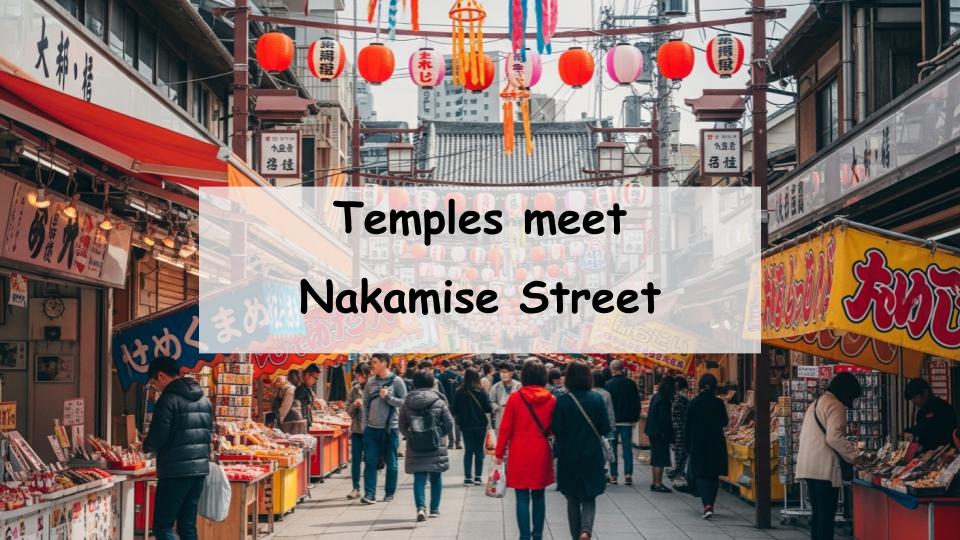Are you curious about temples renowned for their Nakamise streets? Many people want to know which temples are the most popular, or what makes these areas so special. In this article, we carefully select five temples famous for their Nakamise streets and clearly explain their history and unique attractions. By the end, you’ll have all the information you need to enjoy temple visits that combine history, culture, and the lively atmosphere of Nakamise shopping streets.
- What Are Temples with Famous Nakamise Streets?
- 5 Famous Temples with Nakamise Streets
- How to Enjoy Nakamise Streets
- Tips for Visiting Temples with Nakamise Streets
- Conclusion: Enjoy the History and Charm of Temples with Famous Nakamise Streets
What Are Temples with Famous Nakamise Streets?
Definition and Features of Nakamise Streets
A Nakamise street is a shopping street that typically lines the approach to a temple. The most famous example is the Nakamise Street at Senso-ji in Asakusa, Tokyo, which is one of Japan’s oldest shopping streets, dating back to the Edo period. Stretching about 250 meters from the Kaminarimon gate to the temple’s main hall, it features around 90 shops selling traditional sweets, souvenirs, and crafts in an atmosphere rich with history.
Why Are Nakamise Streets Popular with Visitors?
Nakamise streets are beloved because they offer a unique blend of temple visits, shopping, and street food all in one place. The lively ambiance, historic architecture, and variety of traditional goods attract visitors from Japan and around the world. Seasonal festivals and events also add to the appeal, ensuring there’s always something new to discover.
5 Famous Temples with Nakamise Streets
Senso-ji (Taito, Tokyo)
History and Charm of Senso-ji and Its Nakamise Street
Senso-ji, Tokyo’s oldest temple, was founded in 628 AD. Its Nakamise Street has developed alongside the temple’s long history, surviving disasters like the Great Kanto Earthquake and World War II. Today, it remains a vibrant hub for worshippers and tourists alike.
Recommended Sweets and Souvenirs on Senso-ji’s Nakamise Street
Here, you can enjoy classic treats such as fried manju, ningyo-yaki (doll-shaped cakes), and the famous Kaminari-okoshi rice crackers. Traditional souvenirs like folding fans and hair ornaments are also popular.
Kawagoe Daishi Kitain (Kawagoe, Saitama)
Features and Enjoyment of Kawagoe’s Nakamise Street
Kitain’s approach is lined with a Nakamise street that reflects Kawagoe’s historic character. The area is famous for its preserved warehouse-style buildings, and visitors can enjoy local snacks, sweets, and crafts while strolling toward the temple.
Naritasan Shinshoji Temple (Narita, Chiba)
Highlights of Naritasan’s Omotesando and Nakamise
The approach to Naritasan Shinshoji Temple features a bustling Nakamise-style street, offering specialties like grilled eel, yokan (sweet bean jelly), and local crafts. The lively street scene perfectly complements the temple’s historical atmosphere.
Tsurugaoka Hachimangu Area (Kamakura, Kanagawa)
The Appeal of Komachi Street (Nakamise-like Shopping Street)
Near Tsurugaoka Hachimangu, Komachi Street serves as a Nakamise-style shopping area. It’s filled with Kamakura souvenirs, Japanese sweets, and charming cafes, making it a delightful place to explore alongside the historic shrine.
Hasedera Temple (Sakurai, Nara)
History and Recommended Shops on Hasedera’s Nakamise Street
The approach to Hasedera features a Nakamise street lined with shops selling local specialties like persimmon leaf sushi and traditional sweets. The historic townscape and temple grounds offer a rich cultural experience.
How to Enjoy Nakamise Streets
Manners and Tips for Eating While Walking
While eating on the go is popular, it’s important to be considerate of others, especially during crowded times. Dispose of trash properly and try to avoid eating while walking in busy areas.
Seasonal Events and Festivals
Temples like Senso-ji and Naritasan host various seasonal festivals and markets. The Hagoita Fair at Senso-ji and New Year’s celebrations are particularly lively and worth experiencing.
Best Photo Spots
Nakamise streets are full of photogenic spots, from colorful shopfronts to historic buildings and seasonal decorations. Early morning or late afternoon light is ideal for capturing the atmosphere.
Tips for Visiting Temples with Nakamise Streets
Access and Nearby Attractions
Senso-ji is easily accessible from Asakusa Station in Tokyo. Naritasan Shinshoji is a short walk from JR Narita Station, and Kawagoe and Kamakura are also conveniently reached from major train lines. Each area offers plenty of nearby attractions and cafes for a full day of exploration.
Etiquette and Useful Information for Temple Visits
When visiting, purify your hands and mouth at the temizuya (water basin) and quietly offer your prayers at the main hall. Many temples offer goshuin (temple stamps) and charms, which make memorable souvenirs.
Best Times to Visit and How to Avoid Crowds
Spring and autumn are ideal for temple visits, with pleasant weather and beautiful scenery. For a quieter experience, visit on weekday mornings or late afternoons.
Conclusion: Enjoy the History and Charm of Temples with Famous Nakamise Streets
Temples with famous Nakamise streets offer a unique blend of tradition, lively shopping, and local flavors. Whether you’re seeking spiritual enrichment, cultural experiences, or just a fun day out, these destinations are sure to leave a lasting impression. Be sure to visit and discover their timeless appeal for yourself.









Comment